to the index page
In July 1997 I spent three weeks in Hong Kong and Beijing. My twin sister and I, sixteen years old, flew to Hong Kong to visit our uncle and then continued on to Beijing where his wife's parents lived in a village not far from the city center. It was my first time traveling overseas, and my first look outside the predominantly white middle class rural hill towns of western Massachusetts. Hong Kong was a perpetually moving city of tall slender buildings perched on the steep slopes of craggy mountains and wading out into a crowded harbor. I hadn't really had a chance to explore American cities like New York or Boston, so the Hong Kong metropolis seemed especially exotic and exciting in a way that no place I've seen since has come close to. In Beijing we saw a different side of Chinese life, a glimpse of the last remnants of the old Beijing that would vanish almost entirely in the eight years that passed until my next visit.
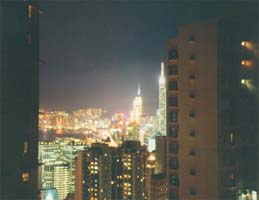
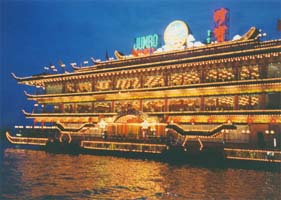
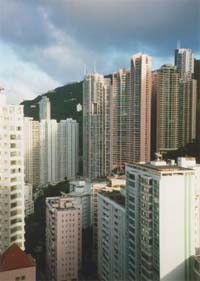
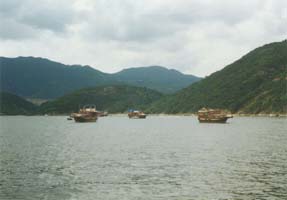
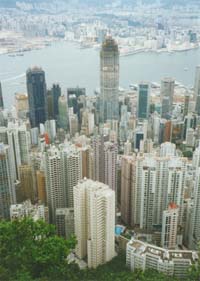
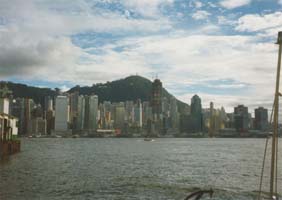
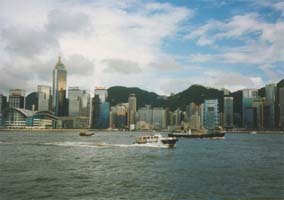
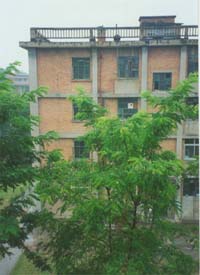
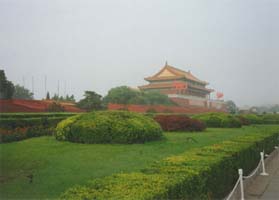
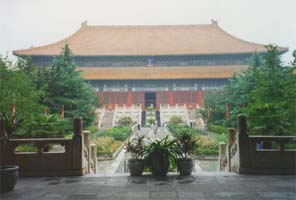
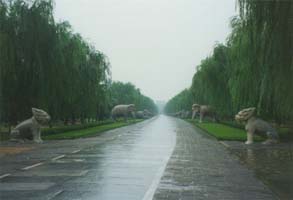
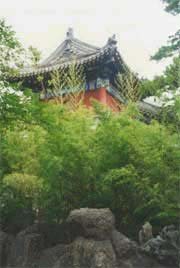
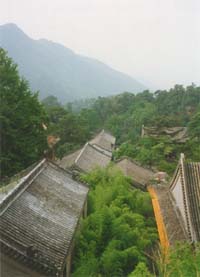
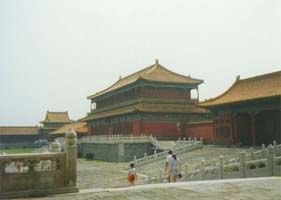
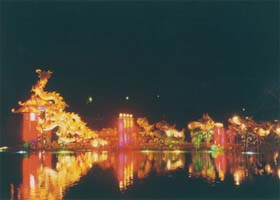
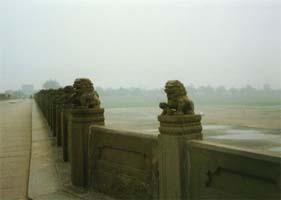
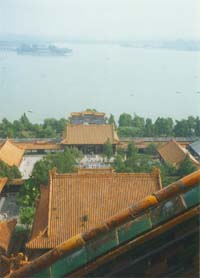
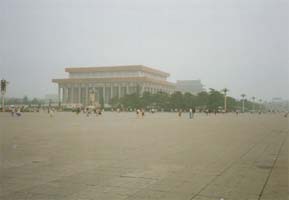
Now nine years and more than a hundred flights later, I'm a well seasoned traveler. It takes more than a new city to impress me and I choose my destinations specifically for their potential to contribute something enlightening or exciting - for example, I went back to China in 2005 to catch a glimpse of Central Asia in the middle of winter. Every now and then though I like to look back over my notes from this trip and remember how it was when what seemed like the entire world had just become within my reach.
July 11, 1997
Nervous about the trip, I had a restless night at a hotel near JFK and got up just after 5am to pack up for the airport shuttle. Back then anyone could go through security to the gates and our parents waved goodbye as we boarded a plane headed for Los Angeles. A year earlier on our first visit to California the cross-country flight had seemed endless, but this time the realization that the fourteen hour flight across the Pacific was still ahead was enough to make the trip seem short. Flying west our plane chased the sun and there was no night until we descended at sunset. Nearing the ground, we began to see small rocky islands. Numerous fishing boats were moving in to shore for the night and V-shaped ripples spread out behind each one. As we dropped lower the sun set over China in a brilliant orange display among towers of cumulous clouds to the west. We dipped low over rocky islands covered with low trees and shrubs and passed over the outskirts of the city. Buildings reached far up the steep slopes, and the bay was filled with boats.
Our uncle was there to meet us at the airport. We took a taxi to this apartment, speeding through the busy traffic with confidence, driving on the left side of the road. We took a tunnel under the bay to Hong Kong Island and followed the narrow winding roads up the mountainside. The city was a blur of lights. Flowers, stars, and other shapes outlined in colored lights adorned many of the buildings, remnants of huge handover celebrations on July 1. The buildings towered skyward, narrow but surprisingly tall. They climbed high up the mountainside; every space was used. Many red taxis zoomed through the intersections and honked incessantly. At length we arrived at my uncle's building, perched high in the hillside above the Central district. An elevator whisked us to his expansive top-floor apartment 28 floors above.
The view of the city and the bay was spectacular, to say the least. Lights of every color extended far into the distance and climbed high up the steep hillsides. We could lean out over the railing of the open balcony and see the tiny cars rushing past hundreds of feet below. After a short rest we took a taxi to the top of Victoria Peak. It was morning back home, and though we had slept little on the flight out we were not tired yet. At the mountaintop, mist drifted in from the ocean. The air was thick and warm, and the big leaves of the tropical plants dripped water. It was an unusually clear night, and we could see the city lights far away on the mainland.
July 12, 1997I slept well despite the hot, humid air and awoke when it began to get light around 6:00 AM. The weather was partly cloudy and the temperature soon rose into the 90s. We went into the city and changed traveler's checks for a stack of bills and some coins, then spent the rest of the day exploring the city. The street markets and shops were very impressive. Antiques shops displayed stamps, bronze artifacts, clay pots, wood figurines, intricately carved stone and ivory, and hundreds of other carvings and sculptures. It was a bit odd to look down at the scattered stone statues underfoot and see price tags equivalent to thousands of US dollars. I stepped carefully.
There were dinosaur eggs priced at $100-400 US, one of which I was tempted to buy but decided against it. The medicine shops were even more interesting, with roots and dried animal parts packaged for sale. Several shops sold the rare edible bird's nests. The nests, 2 or 3 inches across and red, white, brown, and yellow in color, sold for $400 US per package of six. The shops contained hundreds of nests, of unimaginable value. We visited a temple, filled with incense smoke from large hanging coils and rods placed throughout the building. That night we had a delicious dinner with shrimp, small clams, pork, eggs, tomatoes, green vegetables, sliced lotus root... many kinds of food in small dishes that we passed around the table. We had lychee fruit - spiky, golf-ball sized leathery red spheres that once peeled revealed a translucent center that tasted somewhat like green grapes. A smaller green fruit called Dragon's Eyes had a smooth peel and tasted slightly different. We quickly became adept at using chopsticks.
July 13, 1997We prepared for a day on the water and took a taxi through a tunnel to the other side of the island. A small wooden motorboat ferried us to a Chinese junk. It was a very nice boat, about 40 feet long with a polished wood deck, a cabin with a kitchen and bath below, and a smaller upper deck/sunroof. We towed a motorboat out for about a half-hour from Aberdeen and stopped in a bay. We spent the afternoon swimming, eating, and riding around on a long yellow rubber banana boat towed by the motorboat. It was great fun. Four people rode at a time, and we attempted to push each other off at the corners and change places while zipping around the bay.
We passed some big container ships and fishing boats on the way back. The water had gotten rougher and clouds moved in. We arrived back at Aberdeen Marina at dusk and docked among dozens of luxury motorboats. There were two brightly lit floating restaurants in the bay. We returned for dinner at my uncle's apartment and planned the rest of our trip. It was Sunday, and the following Friday we would fly to Beijing.
July 14, 1997It was another nice day, with a mix of sun and clouds. We took it for granted, but my uncle said it was very unusual because it had been raining a lot before our arrival. After breakfast we went to the Hong Kong Zoo and Botanical Gardens. There we saw many interesting birds and animals, including a jaguar, monkeys, and a mouse deer, a tiny deer only one foot tall. We continued on to Hong Kong Park, a nice area of trees and fountains in the middle of the city. From there we took the Peak Tram to the top of the mountain. The cable-pulled cars ran on rails that went straight up the mountainside. At the summit we did a little shopping and then walked 2or 3 miles on a trail around one peak. It was surprising how far away we could get after just a short walk. The trail cut across the cliffs, sometimes built on concrete supports where the slope was too steep. The view was spectacular, and we could see the city, the bay, Kai Tak airport and the new airport in the distance, with a long suspension bridge leading to it from the mainland. On the far side of the mountain we walked through dense bamboo thickets. The trail came back to the place we started from, and we walked down the steep, winding Old Peak Road back to the apartment. Heavier rain set in after we returned and we saw some distant lightning.
July 15, 1997We took a taxi into the city to get photos taken for our visa applications. After finding the coin-operated photo booth in the subway, we had an adventurous time taking the bus back. There were many buses, streets, and numbers, and it was hard to find the right one. Walking around in search of bus stops, we saw a little more of the city. From the elevated walkways we could see construction in the streets below in some places. It was amazing that the streets were only a few feet thick, and below there was another world of subterranean walkways, subways, and utility tunnels. The buildings rose far above the seemingly solid surface but also continued far below it. The air, hot and humid, was wade worse by great clouds of auto exhaust. Drivers here use their horns every few hundred yards, honking instead of stopping. They careen around corners and sail through intersections, seemingly careless but undoubtedly experienced. Fortunately, elevated walkways connect many buildings and the escalator system, making foot travel easy. Masses of people rushed through the smoggy walks, at least half in busy conversations on their cell phones.
That afternoon we took a bus to Ocean Park on the other end of the island. There were some rides, an aquarium with some very large fish, and a tramway that we took up over a mountaintop to the rest of the park. It was foggy, but the views were still impressive. We watched a show with trained seals, sea lions, dolphins, and a killer whale. It was amazing how friendly and well trained they were. They jumped through hoops, balanced balls, and swam around the pool. The whale pushed a swimmer around the pool with its nose, and a seal, acting, pushed a person in to the water and, after he had climbed out, pretended to perform CPR on the motionless body. The animals seemed to be very smart and did everything for snacks of small fish.
July 16, 1997It was another hot, breezy day with clear skies. We took a ferry 5 minutes across the bay to Kowloon. The water was choppy, but the ride was smooth. There was a large theater showing a film on whales, but the next open show given in English was at 6:30 so we decided not to go. We went to the Hong Kong Museum of Art instead and happily discovered that admission was free on Wednesdays. We returned to the island, met my uncle at his 12th floor office, and continued to the 49th floor for lunch at an American restaurant there. After lunch we walked around the unusual steel and glass structure that was the new Bank of China building and then took the ferry back across to Kowloon. We toured the space museum and walked through the shops in some of the high-class hotels before going to Kowloon Park. There were some showers between sunny intervals, and I was glad I had brought my umbrella. In the park we went to the Hong Kong Museum of history. There were interesting exhibits, pictures, and films telling the story of the island. It had been a wild, forested jungle paradise but now there were few trees or large animals left.
After walking through the park, we crossed back to the island and took the escalators back up to the apartment. A series of escalators separated by short walkways and covered by a roof extended from the Central district on the waterfront several hundred feet up the mountain.
July 17, 1997It was raining hard the next morning. The mountainside was shrouded in fog and I could see water cascading down the cliffs where there had previously been no streams. At 9:30 the rain had let up, and we took the escalator down into the city and dropped postcards at the post office. For HK $7.50 we got a bus across the island to Stanley Market, a well-known shopping area. The closely packed stands were covered by makeshift roofs and filled with all kinds of collectibles, clothing, arts, and food. There was no sales tax, which was convenient because there was no need for small change. It makes more sense than our sales system. I didn't buy much, finding many things above my budget or difficult to pack home, but I secured a few souvenirs. We returned on the bus around 3:00. Later, I explored the streets near the apartment building. At the end of a winding alley I came across a small pen of red chickens. Even in the city people try to raise animals and vegetables. Back at the apartment, we packed for the next leg of the trip. After nearly two weeks in Beijing we would return to Hong Kong for only one night before departing for home.
July 18, 1997We left for the airport at about 9:00 and just made the 10:20 flight after slogging through traffic and checking in. The plane was very empty, and we soon moved to window seats to see the land below. After a delay, the Boeing 767 finally took off at 10:50 for the 2 hr 40 min flight to Beijing. The safety video was in Chinese, with fuzzy English words written on the screen. We passed through broken clouds over dark green fields and low hills and then moved out over brown prairie with many small villages scattered close together and interconnected by a network of roads. We landed at 1:30, went through customs and immigration, and claimed our bags. We rode in a friend's car for an hour and a half to the apartment where my aunt's parents lived. The city of Beijing was cloaked in smog and blended in perfectly with the brown dusty fields surrounding it. We sped along with the fast-moving traffic, this time on the right side of the road. The taxis were yellow instead of red, and there were almost no foreign-made cars because of the communist government tariff policies. Signs along the road were in both English and Chinese, but other signs were written only in Chinese.
The apartment was on the third floor of a brick and concrete government building, but it had been refinished and remodeled to be quite nice. As in Hong Kong, water had to be boiled before drinking. It was a quiet area, away from traffic noise. The village was like nothing I had ever seen before, and it was apparent that my sister and I were not something commonly seen either for people stopped and stared wherever we went. The area was relatively remote and it was not close to any tourist sites, and foreigners had not been allowed to enter the region until recently. Furthermore, two 16-year-old Americans had probably never been seen there in a very long time. Though we were quite a spectacle to the villagers, the village itself was more of a spectacle to us. The street market was a few hundred yards away, on a dusty section of street. Vendors sold fresh fruits, meat, eggs, live crayfish, deep-fried breads, and dozens of other things. There were red brick buildings scattered about and trees shaded the road. Since cars were very expensive even by American standards and the income of most people so low, there was almost no traffic. The primary means of transportation was by bicycle. Cycles lined the streets and people rode to and from the market loaded with the day's goods. It was very hot and the sky was a hazy brown that blocked out some of the sun.
We were treated like royalty because we were from the States. Dinner was very good, and our hosts pushed more and more food at us so we might be completely satisfied. We took food from many dishes - fish, potatoes, tofu, rice, peppers, green vegetables, watermelon, green-white peaches, and many others. It got dark later than it did in Hong Kong, at about 8:00. It was a custom to walk after dinner, and we went out into the quiet evening. There was a dirt sports field and arena, lit by electric lights, a short distance away, and there were many people there. They danced to Chinese music on a paved lot with terraced stone bleachers above it on the hillside. We watched the dancing until just after 9:00. There was a nice breeze, and a few kites had flown high before it got dark. There were high clouds in the sky, but a full moon was nearly visible. Crickets and other insects chirped loudly in the still, warm air. In a market booth we had seen small basket cages, three inches wide, with loudly chirping crickets inside. They seemed to be nice pets, indifferent to the fact that they were caged.
July 19, 1997It began to get light at about 5:00 am and arrived at the market, driving old tractors and riding bicycles. Vendors set up their shops and the villagers set out to do the day's shopping. The street was bustling before 6:00. Breakfast was not usually a big meal there, but they cooked up a meal for us. We set out for the Ming Tombs and the Great Wall in a chilly rain, riding in a friend's car. Here as well, drivers used the auto horn frequently to warn pedestrians, turning cars, and cars being passed. We passed often, driving between 100 and 140 km/hr and weaving among ancient farm trucks chugging along.
The Ming Tombs were located in a picturesque valley. Jagged hills covered by low shrubs rose out of the mist, and trees lined the walkways. The tombs themselves were not very impressive, having been emptied of all their contents, but the gates and pathways between tombs were beautiful. Carved stone animals lined the walk, and the intricate architecture of the gate buildings was quite nice. Huge wooden pillars 3-4 feet wide at the base supported the roof of the largest building. They had been brought from southern China long ago when such trees still grew there. We watched a film about the excavation of the one opened tomb (there are 13 in the valley), which unfortunately was in Chinese.
We continued on up into the mountains, passing peach orchards and many farm stands selling the fruit. The two-lane road wound upward and large blue trucks laboriously moved up the grade. Traffic passed them on the right or left, which ever was convenient, and sometimes we stayed in the wrong lane for miles at a time. After much waiting and fighting traffic, we came upon a KFC and stopped for lunch. I was surprised to find an American restaurant here; it was very popular. Returning to the wall, we saw immense crowds of umbrella-clad people waiting to climb onto the wall. Since we were foreigners, we had to pay more (a government use fee of some sort) but we didn't have to wait in line. We took a short ride on a cable car to the wall, and then had to wait in another line as they checked tickets. There was not much to see from the wall, though the structure itself was impressive. It was built out of a dark gray stone and had been restored to good condition for tourists to see. The wall was steep at times, sometimes a smooth ramp and sometimes stepped, and it zigzagged back and forth along the ridges. There was a break in the structure where it came up abruptly to a cliff; the wall resumed at the top of the cliff and a secondary wall led a path around. This section was the Badaling section, one of the most scenic areas of the wall. The drive back was scenic, winding through steeply sloping treeless hills. There were some low shrubs and pine or spruce trees, and red-brown rocks were exposed on steeper ridges. The driving was slow, and we arrived back at the apartment at about 8:00.
American music was playing on the radio, and it seemed to be popular. I only heard a couple of people speaking English at the Ming Tombs and the Great Wall. It was difficult to communicate without knowing Chinese; people would speak to us in Chinese and we were unable to answer. We enjoyed another good dinner with pasta and many dishes of meat and vegetables, all cut up into small pieces to be eaten with chopsticks. There was music near the market in the evening. It was a pleasant community, small and peaceful.
July 20, 1997We encountered more unusual foods the next morning, some of which did not appeal to me much. Peanuts were sold in the market; these were boiled and eaten fresh. They were translucent white, soft, and slightly crisp, with a nutty flavor not like the taste of roasted peanuts. We also had corn-on-the-cob, but it was some sort of meal corn, dry and not sweet.
First we went to the Peking Man site. There was a small museum and trails winding among the caves. Access was not restricted as it would have been in America, and we climbed around inside the excavated caverns. The weather was hot, and the sun shone through the haze. For lunch we went to a Szechwan style restaurant. This type of food was spicy, like Mexican food, and quite good. Many dishes were ordered and placed on a large rotating glass plate in the center of the round table; we each took small pieces of what we wanted and put them in our bowls.
We continued on to one of the Summer Palaces. Soldiers acting against the Boxer Rebellion had destroyed this one, built in European style, in the 1800s, so only scattered ruins of the white marble palace remained. It was impressive nonetheless, perhaps more so in it's fallen state. Huge chunks of beautifully carved marble lay on the ground, giving us a glimpse of the ornate palace we saw in models and pictures. Next we saw another Summer Palace, this one with Chinese architecture. This one had been burned down but rebuilt. A common feature of each was the abundance of lakes and canals, through which we rode in small boats to get from one side of the palace to the other.
That evening, after dinner, we walked in the twilight to an ancient Buddhist tower a short distance up the road. It was a peaceful evening. A shepherd passed by with his herd of sheep. It was so different from the States - a simpler life, but perhaps a better one.
July 21, 1997The skies remained cloudy or hazy through the day. I noted that we had not yet seen blue sky here, though the sun shone. Smog or desert dust perpetually colored the sky a light brown. The entire landscape was rather colorless.
We took a taxi into Beijing, a tiny yellow van, and spent the morning at a zoo. There were many animals, and we saw pandas and tiny chipmunk-sized monkeys. It was very hot and uncomfortable weather. Later in the afternoon we went to Tiananmen Square, a very large, hazy plaza surrounded by museums and the Forbidden City across the highway. Many of the museums were closed so we walked around the Square and the gardens of the Imperial Palace. Returning home, we passed many people riding bicycles or large tricycles hauling bricks, produce, or people. It looked like a very hot job. All the bikes were well used and rusty.
July 22, 1997We took bicycles to the Marco Polo Bridge, only a few miles away at the Yongding River. I longed for my mountain bike to replace the rattling contraption I was given. The riverbed was dry and dusty with only a few pools of water. The bridge was built of gray stone and had carved stone lions, every one different, spaced out along the spans. The bridge is historically important: it was first built in 1192, but the original arches were washed away in the 17th century. It is best known for the Marco Polo Bridge Incident on July 7, 1937, when fighting erupted with Japanese troops camped nearby. The event marked the place and time that China entered WWII. We went to a museum with exhibits about the war and saw interesting displays. There was a film (all in Chinese, of course), and we went inside a replica underground bunker that would have been tunneled into a hillside. The replica was in concrete and plaster, but tiny and cramped nonetheless.
The restaurant where we ate lunch had tanks at the front with frogs, snakes, crabs, and fish - fresh food! That evening while we were out walking it suddenly became very windy. The power in our building went out, and we could see lightning in the west. It sprinkled lightly but then blew past. The power returned by about 9:30.
July 23, 1997The weather system that had moved in made the air cooler and much more comfortable. We spent the day touring temples in the hills outside Beijing. On the way we passed many bicycles, tractors, and a few mule-drawn carriages. We first stopped at a monastery in the mountains with winding pathways and beautifully decorated buildings. We drank water from a legendary spring and saw a Buddha statue in a cave, guarded by a tiger statue. We next moved on to a temple famous for its ancient gnarled trees, some more than a thousand years old. There were many kinds of trees growing among the buildings. Vendors at the entrance sold cages with chipmunks, crickets, parakeets, and songbirds.
We went to aanother house for dinner, where we were again treated like royalty. Though they lived a simple lifestyle, our hosts put together an immense dinner. The hospitality of people impressed me. The sky cleared as we walked back and some stars shone through the haze.
July 24, 1997We were up as usual at 6:00 the next morning, though the bustle outside at the market had begun more than an hour before. We packed up and headed into the city to stay at a hotel with my uncle, who was on a business trip. The air conditioning at the Great Wall Sheraton was very welcome. A few minutes after arriving we went off to the Imperial Palace. Temperatures were in the high 90s, so it was rather uncomfortable to walk around on the hot stone plazas. The buildings were quite impressive and large; it took almost 20 minutes to walk across the palace.
After dinner at a restaurant across the street we went to a park with hundreds of glowing lanterns and dragon sculptures. Some of them were put up to celebrate the return of Hong Kong to China.
July 25, 1997We went to another temple in the city with the tallest Buddha statue in the world - 18 meters tall and carved from a very large piece of wood, covered in gold. It was hot once again, with an expected high of 99 degrees. We learned that it had not been this hot for so long in 40 years. I was looking forward to our return home; China was fascinating but not a place where I could stay for long. Life was so different that I could not settle in; I was only a passing visitor. We walked around a park for part of the afternoon, waiting impatiently for the frozen bottles of water we bought to melt into a drinkable form. We took a taxi back to the hotel and walked through the shops in the hotel across the street. Jade carvings priced at thousands of US dollars sat underfoot on the floor, and we picked our way carefully through the store.
For dinner we went to the Hard Rock Café. The Western food was welcome. We saw Chinese life at yet another angle - not the small town, low-income life, but a more modern imitation of America. We heard American music, saw American videos, "Made in the USA" clothing, slogans such as "The land of the free," American advertising on television.... People try to be like Americans, but at any time the government can intervene and block out foreign television and news, take away the music, or do anything else deemed necessary to retain social stability.
July 26, 1997We went to a furniture restoration gallery in the morning. Intricately carved screens with exquisite detail were being cleaned and refinished, then sold for very high prices. There were probably millions of dollars of furniture in the warehouses. Dinner that night at the Landmark Hotel was good. One interesting dish - Drunken Prawns - was prepared before us. Prawns were put in alcohol until still and then lit on fire. Two jumped out, but soon all were eaten. Another dish had pieces of fried chicken - the whole bird, including the head. Though the food was delicious and filling, I missed great slabs of steak and potatoes or heaps of pasta. Chinese food is very delicate, and though it is very good I prefer big, solid American meals in the end.
July 27, 1997It was Sunday morning, and there was not much to do but walk around the hotel shops. We were invited to lunch with one of my uncle's friends at his furniture museum restaurant. He owned millions of dollars of restored furniture and marketed it around the world. We ate with him and another couple, who we later learned were friends of the vice premier of China. The restaurant was of the highest class - one of the best in the country. It was a small private restaurant so we were the only customers, and our food was prepared with great care. It was brought in small dishes, which were taken away and replaced with something new as we finished them. Every time I thought we were finished, a new course arrived. It was by far the nicest place I had ever dined at.
Later in the day, we went to a market. It was very crowded and most of the shops sold clothing. Everything was rather expensive and we decided to buy souvenirs at the hotel shops instead where we got a 20% discount for staying at the hotel. We cashed more checks to pay the export taxes - it would cost us 90 yuan to leave China and $100 HK to leave Hong Kong.
July 28, 1997We visited my uncle's office in the morning and then had lunch at a restaurant. We ordered Peking Duck - the duck was brought out whole for our inspection and then sliced into pieces. It was similar to chicken, but with darker, oily meat and golden skin. We made a rushed exit from the hotel to catch our flight, and after a quick goodbye at the airport my sister and I boarded the already loaded plane ten minutes before its scheduled departure. The departure was delayed about a half hour and we finally took off in light rain at 2:50. We landed in Hong Kong at 5:40 and walked through customs with only a few words. Landing in Hong Kong was almost like coming home - someplace familiar where at least some people spoke English. We took a bus to Central and got a taxi from Central to my uncle's apartment, then took a taxi back down to meet my uncle for dinner. It was an American restaurant - good for a change - and we sat looking out over the bay. In the darkness the lights of the city shimmered brilliantly, and we could see boats in the harbor. It was a beautiful night, mostly clear and warm. We would take a bus to the airport at 8:00 the following morning. I was both excited and reluctant to go away from this fascinating place.
July 29, 1997We would spend an entire day and a half traveling, arriving in New York at 4:30 in the morning HK time, the same time in the afternoon at home. We took a taxi with my uncle to a bus station in Central and after saying goodbye, took a bus to the airport. Our fight back to New York went through Tokyo; our course would take us over the coast of Alaska and across Canada to New York. It began to get dark around 5:00, and the setting sun lighted the clouds below. Within about 15 minutes the clouds changed from bright white to dark gray as the sun dipped below the horizon, accelerated by our 600 mph Eastward motion. At 7:00 it was deep night, but by 9:30 it was getting light again. At 10:45 we were passing over snow-capped mountains that poked through the clouds. We passed over great expanses of flatter land dotted with lakes, eventually reaching the shores of Lake Huron and then passing over Lake Ontario. It looked just like a map from up in the sky. I saw the Finger Lakes to the West, and then the Hudson River. At 4:00 we were over Manhattan. The sky was cloudless, and we could see the buildings below perfectly. The Statue of Liberty was a small blue dot in the harbor and the twin towers of the World Trade Center looked like tiny models. We passed over the marshy coastline of Long Island and landed early at JFK.
It didn't take long to get back into the usual schedule back home. Once I was back, the trip seemed almost surreal. I vividly remember flying into Hong Kong for the first time, with the sun setting over China, the boats below returning to their harbors, and the blur of lights and towering buildings I saw that first night in the city. I remember the small villages outside Beijing and the street markets in Hong Kong, the simple lives of the shepherds and farmers and the multi-million dollar lifestyles of the businessmen. The experience helped me to understand a little better what the world is like and made me realize what is so special about living in America.
to the index page